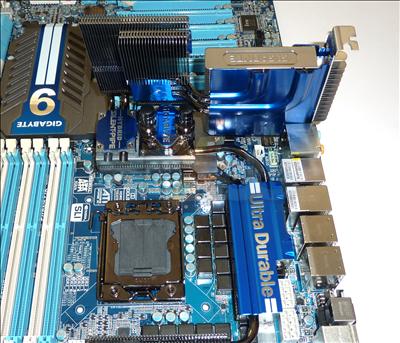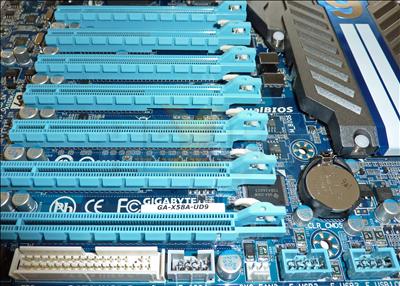Features galore
It is feasible to have both the waterblock and SilentPipe 2 heatsink working in tandem, increasing cooling performance, but non-liquid-cooling users who want to remove the block can do so by undoing a few simple screws.
Being X58, six DIMM slots are available, scaling up to DDR3 memory operating at 2,200MHz, and we expect most enthusiasts to fill them. Power and reset buttons - now staple fare for enthusiast-class boards - are close by.
So why the need for extra width and height of PCB? The reason is the same as for the EVGA Classified, that is, the PCB space required to house bridging chips that boost the X58 chipset's 36 PCIe lanes. There's little point in having seven full-length PCIe slots if bandwidth cannot be allocated in a sensible manner.
This is why the GA-X58A-UD9 ships with two nF200 chips that hang off the X58 IOH. Add it all up together and total PCIe allocation means that you can run four graphics cards at x16 for either four-way SLI or four-way CrossFire.
And here are the slots. Looking from the top the first, third, fifth and seventh slots all work at x16 electrically. The in-between slots operate at 8x. This means that you can have double-width cards arranged in a four-way grouping. The bridge-covering heatsink connects to the X58 IOH's and whilst well-made, it doesn't feel very substantial.
Moving away from the cornucopia of PCIe laneage, the board also ships with two white SATA 6Gbps ports that are powered by a Marvell controller. Confusingly, a further two SATA 3Gbps ports are also coloured in white, and another six - powered by the southbridge - are coloured in blue.
As expected on a high-end board, USB 3.0 is thrown into the mix courtesy of the familiar NEC controller.
Realtek chips in with dual Gigabit Ethernet and high-definition audio, and Gigabyte doubles-up on a couple of rear I/O ports by offering a pair of eSATA/USB combo ports.
Rounding off the connectivity options, you'll find four more USB 2.0 ports, two USB 3.0 ports, FireWire and mini FireWire, optical and SPDIF out, a pair of PS2 keyboard and mouse connectors, and the ever-useful clear CMOS switch.
There's plenty on offer, plenty of room to work with, and little to criticise. If we were being picky, we'd add that Gigabyte's light-blue-and-white colour scheme doesn't exactly reflect the hardcore nature of the board.
Looking at the feature set, it's an impressive board but is it worth 467 little gold coins? Putting the price into perspective, other X58 boards costing half that amount offer SATA 6Gbps, USB 3.0 and support for three-way CrossFire and SLI. And they'll fit in your existing chassis, too.
The added premium for the UD9, it seems, revolves around overclocking prowess and support for niche, four-way GPU configurations.













